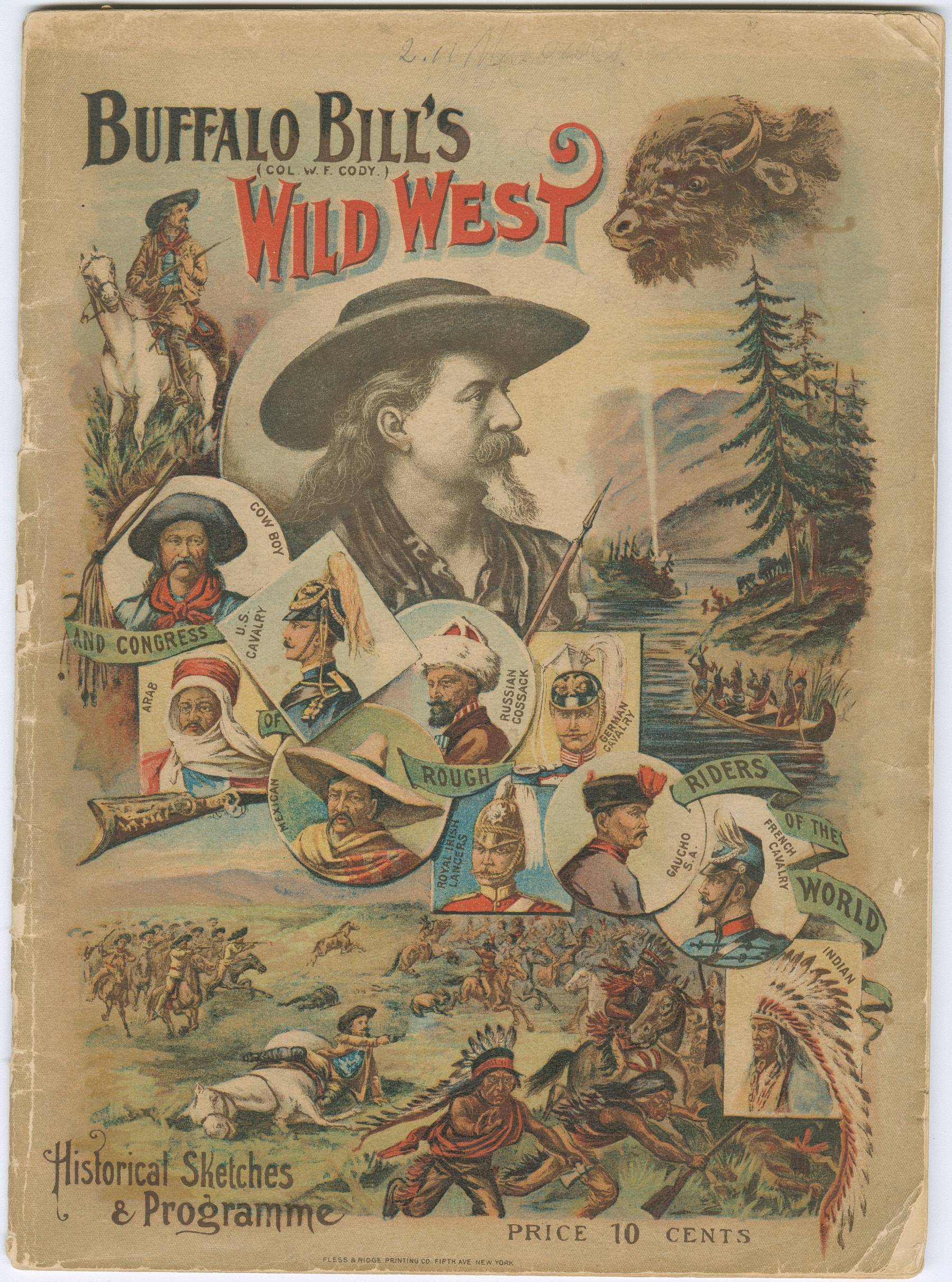World’s fairs produced and disseminated Orientalist imagery to millions of attendees in Europe and the United States. Massive multiacre spectacles, they showcased artworks, commercial products, architecture, design, science, technology, and people from across the globe. Their stereotyped advertisements and exhibitions frequently reinforced harmful racial hierarchies. However, global representatives used their voices, cultural authority, and artworks to assert their presence and identities and to counter biased assumptions.
Over 27 million visitors attended the 1893 World’s Columbian Exposition in Chicago during the six months it was open, including artists Frederic Remington and Charles Russell. North African exhibitions, including the Cairo Street and Bedouins performing as part of the “Wild East,” left impressions on both men. Their shared interest in Bedouin and Arab equestrian cultures may reflect their awareness that horsemanship in the Americas had, in part, originated with the Spanish colonial armies, whose own horses, tack, and techniques had been influenced by North African breeds and practices.
World's Fair
Published by Rand, McNally & Co.
A Week at the Fair: Exhibits and Wonders of the World's Columbian Exposition
1893
Colored ink on paper
9 × 6 in.
Object #2014.039, Buffalo Bill Museum and Grave, Golden, Colorado
Blanche L. Snow for The Werner Company
Egyptian Mosque at the World’s Columbian Exhibition
1893
From Portfolio of Photographs of the World’s Fair, Art Series No. 10
11 × 13½ in.
Denver Art Museum, EXACC.2022.33
Blanche L. Snow for The Werner Company
Life Group of Plains Women Dressing Hides Presented by the Department of Ethnology and Bureau of American Ethnology. Photograph of interior view of Smithsonian Institution and US National Museum exhibits in the US Government Building. From Portfolio of the World’s Fair, Art Series, No. 15.
1893–94
Denver Art Museum
Spread across nearly 700 acres, the Columbian Exposition included large temporary buildings arranged around a central water feature. Internal exhibits showcased technology, society, industry, and art. Along the mile-long Midway Plaisance, visitors found food, entertainment, the first Ferris wheel, and “living exhibits” of global cultures. While providing a venue for intercultural exchange, the arrangement of the displays and their stereotyped representations often reinforced harmful racial hierarchies.
Courier Litho. Co.
Buffalo, NY.
Buffalo Bill’s Wild West and Congress of Rough Riders of the World: An Arab Poster
1896
Ink on paper
28 1/2 x 42 in.
Object ID# 73.0677, Buffalo Bill Museum and Grave, Golden, Colorado
Unknown publisher
Buffalo Bill's Wild West, Historical Sketches & Programme
1894
Colored ink on paper
9½ × 7 in.
Object # 2001.0014, Buffalo Bill Museum and Grave, Golden, Colorado
Charles Marion Russell
Street Scene in Arabia
1908
Watercolor on paper
9¼ × 6½ in.
C. M. Russell Museum: Gift of the Josephine Trigg Estate, 953-1-018
Although not formally a part of the 1893 Columbian Exposition, Buffalo Bill’s Wild West show set up camp outside the fairgrounds and became one of the summer’s main attractions. Demonstrations of sharpshooting, roping, and riding punctuated dramatically staged scenes of Old West violence. In addition, performers including Cossacks, gauchos, vaqueros, and Arabs demonstrated their athletic skills as part of the Rough Riders of the World.
Indigenous Art and Tiffany
Paulding Farnham (designer)
Tiffany & Co. (manufacturer)
Pueblo Vase
1893
Sterling silver, inlaid with copper, niello, and gold
6 × 12½ in.
Exhibited at the World's Columbian Exposition, 1893, Chicago, IL. Tiffany & Co. Archives, B1993.01. © Tiffany and Company 2023.
Acoma artist
Jar
1895-1900
Clay and paint
11¼ x 13¼ in.
Denver Art Museum: Gift of Mr. C.W. Douglas, 1929.50. Photography by Bill O'Conner, courtesy Denver Art Museum
Zuni artist
Bowl
1890s
Clay and paint
6 1/4 x 13 15/16 in.
Denver Art Museum: Exchange with Indian Arts Fund, 1929.140. Photography by Bill O'Conner, courtesy Denver Art Museum
At world’s fairs, Indigenous arts were often displayed within ethnographic exhibitions, emphasizing a perceived distinction between art and artifact. By the late 1800s, however, Indigenous arts circulated throughout international markets and directly impacted European and American art and design. For example, George Paulding Farnham’s Pueblo Vase, exhibited for Tiffany & Co. at the 1893 Columbian Exposition, references motifs and forms of Pueblo vessels. By transforming and appropriating Indigenous designs, such artworks simultaneously celebrate and attempt to replace Indigenous artists.
Frederic Remington
A Note from the Wild East–Midway Plaisance–Chicago
1893
Mixed media on board
31 1/2 x 32 in.
National Cowboy & Western Heritage Museum, Gift of Jasper D. Ackerman
Frederic Remington
“A Revolver Charge” illustration for “An Arabian Day and Night” in Harper’s New Monthly Magazine
1894
Ink on paper
10 × 7 in.
Denver Art Museum: EXACC.2022.13
Unknown Algerian artist
Spurs
about 1900
Leather with heavily ornate brass
about 1900
5 × 2¾ in.
Buffalo Bill Center of the West, Cody, Wyoming: Gift of the Coe Foundation, 1.67.193
Frederic Remington’s sighting of Bedouin riders at the 1893 Columbian Exposition, which he captured in his cover illustration for Harper’s Weekly, inspired a trip to Algeria the following year with writer and editor Poultney Bigelow. Remington’s illustrations accompanying Bigelow’s essays feature a variety of lively depictions, including charging Arab riders. Remington returned to the United States with sketches, photographs, and even stirrups and spurs that he displayed in his studio.

Near East to Far West: Fictions of French and American Colonialism is organized by the Denver Art Museum. It has been made possible in part by a major grant from the National Endowment for the Humanities: Democracy demands wisdom. Research for this exhibition was supported by the Terra Foundation for American Art. It is presented with generous support from Keith and Kathie Finger, the Gladys Krieble Delmas Foundation, Sotheby's, the donors to the Annual Fund Leadership Campaign, and the residents who support the Scientific and Cultural Facilities District (SCFD). Promotional support is provided by 5280 Magazine and CBS Colorado.












